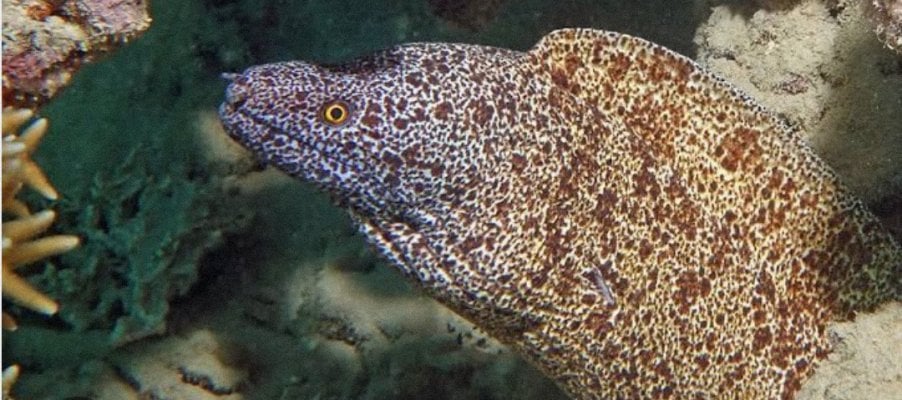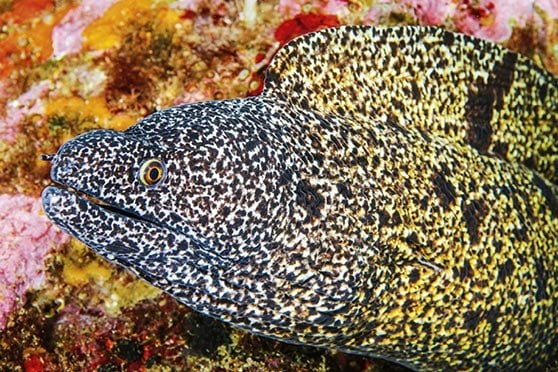Navigation
Install the app
How to install the app on iOS
Follow along with the video below to see how to install our site as a web app on your home screen.
Note: This feature may not be available in some browsers.
More options
You are using an out of date browser. It may not display this or other websites correctly.
You should upgrade or use an alternative browser.
You should upgrade or use an alternative browser.
Ever heard of the lord howe moray?
- Thread starter HAAAAAAAA
- Start date
- Tagged users None
looks cool!
I haven't thought about a Moray Eel in years. Those scared me as a kid.
It's not sold in the hobby that I've seen, likely because they're only found in a pretty small area of the ocean under Australian jurisdiction (basically around small islands east of Australia where the southern end of the Coral Sea meets the northern end of the Tasman Sea) - I'd imagine it'd be a bit of a hassle to collect them (so it's probably easier to provide a substitute like the Kidako Eel), and a bit of a nightmare to get export permits.I wonder why I have not seen or even heard of anyone keeping this moray (gymnothorax annasona) it's such a beautiful and spectacular species but would the main reasons be because it's hard to find? Or hard to keep in captivity? Or just that because it isn't known as much?
That said, it's true that it's not well known, but it's probably not particularly difficult to keep.
You're right! I didn't think about it in that way since I believe that I've seen some of these particular moray's in certain YouTube videos but are definitely rare, for example I have a gymnothorax dovii which are more commonly found in the Galapagos islands but they somehow made their way into the Indian ocean and then to my aquarium Lol, it might be because of the spawning or mating season, here in india, I believe that the season for moray's is in spring which is March here! Definitely one of those times when I first saw a gymnothorax isingteena and a pure albino fimbriated eel without any black markings! I believe that i still have the video of the albino moray and the isingteena on which the seller sent me would you be interested to take a look and confirm their species?It's not sold in the hobby that I've seen, likely because they're only found in a pretty small area of the ocean under Australian jurisdiction (basically around small islands east of Australia where the southern end of the Coral Sea meets the northern end of the Tasman Sea) - I'd imagine it'd be a bit of a hassle to collect them (so it's probably easier to provide a substitute like the Kidako Eel), and a bit of a nightmare to get export permits.
That said, it's true that it's not well known, but it's probably not particularly difficult to keep.
Yeah, sometimes species end up in odd places, but it's much less common, haha.You're right! I didn't think about it in that way since I believe that I've seen some of these particular moray's in certain YouTube videos but are definitely rare, for example I have a gymnothorax dovii which are more commonly found in the Galapagos islands but they somehow made their way into the Indian ocean and then to my aquarium Lol, it might be because of the spawning or mating season, here in india, I believe that the season for moray's is in spring which is March here! Definitely one of those times when I first saw a gymnothorax isingteena and a pure albino fimbriated eel without any black markings! I believe that i still have the video of the albino moray and the isingteena on which the seller sent me would you be interested to take a look and confirm their species?
Sure - I'd love to see the eels (and I'll see if I can confirm them or not).
Thank you! Just having a look at these guys again makes me sad for not getting them at the time since i didn't have a suitable tank for them, but what do you think? I don't know if the white yellow head moray is a fimbriated or not but that is one cool colour!
Yeah, sometimes species end up in odd places, but it's much less common, haha.
Sure - I'd love to see the eels (and I'll see if I can confirm them or not).
[/QUOTED/]
Attachments
So, this got me wondering because that's a huge span of ocean to cross - I'd guess your eel is more likely the Red Sea Whitespotted Moray, Gymnothorax punctatus; these are known to be found around India's coasts (both sides) and can sometimes look remarkably similar to G. dovii [Eastern Pacific], G. jonhsonii [Eastern Africa], as well as sometimes G. prionodon [Australia]; there's some speculation that some of these may be/have multiple cryptic species in them too - regardless, more study to figure out proper morphological and genetic differentiation of these species has been suggested).I have a gymnothorax dovii which are more commonly found in the Galapagos islands but they somehow made their way into the Indian ocean and then to my aquarium
While G. dovii has been reported from the Gulf of Mexico and the southern tip of India, I'd guess those are both likely misidentifications.
For reference there:
Gymnothorax punctatus Bloch & Schneider 1801 - Plazi TreatmentBank
Gymnothorax johnsoni - Plazi TreatmentBank
I agree with G. isingteena there - G. favagineus looks remarkably similar sometimes, but the spots on your eel there are large, few in number, and seem relatively round (not blocky), which fits the distinction below (which seems to be consistent from what I've found):Thank you! Just having a look at these guys again makes me sad for not getting them at the time since i didn't have a suitable tank for them, but what do you think? I don't know if the white yellow head moray is a fimbriated or not but that is one cool colour!
"On the pale brown background stand out countless dark roundish spots which at times touch thus outlining circular or horseshoe-like drawings. They are present, like the Gymnothorax favagineus, also inside the mouth, but it is impossible to mistake it with this species due to the circular and not squared shape of the spots, which do never form reticula, due to the relatively small size and the remarkable distance between them."*
Basically, the spots of G. isingteena are generally relatively few, large, and smoothly circular in shape, sometimes joining together to form little shapes on the body; G. favagineus' spots are typically numerous, small, blocky in shape/jagged around the edges, and don't join together to form shapes (I have seen spots that look like two or three joined together, but they don't form shapes/patterns like on G. isingteena - you can see the spots I'm talking about in the links below).
*Source (and a separate link for G. favagineus to give photos of both for comparison):

Gymnothorax isingteena - Monaco Nature Encyclopedia
Family : Muraenidae Text © Giuseppe Mazza English translation by Mario Beltramini Medium…
 www.monaconatureencyclopedia.com
www.monaconatureencyclopedia.com

Gymnothorax favagineus - Monaco Nature Encyclopedia
Family : Muraenidae Text © Giuseppe Mazza English translation by Mario Beltramini Indo-Pacific…
 www.monaconatureencyclopedia.com
www.monaconatureencyclopedia.com
I don't think this one is a fimbriated, but I'm not sure what it is - the Golden Dwarf Moray, Gymnothorax melatremus, seems the most likely to me, but I'm not confident on that one. Maybe @Slocke would have an idea of if G. melatremus is a good guess or not here.I don't know if the white yellow head moray is a fimbriated or not but that is one cool colour!
I know a handful of other species that can show this coloration, but all of them are extremely unlikely, as this would be aberrant coloration for them like it would be with the fimbriated moray.
Last edited:
Slocke
I’m pedantic, ignore me
View Badges

Excellence Award
Reef Tank 365
Photo of the Month
Article Contributor
My Tank Thread
My Aquarium Showcase
I can’t say better than you. I tried. Got annoyed at fishbases terrible photos/lack of photos and gave up. Not feeling the ID game todaySo, this got me wondering because that's a huge span of ocean to cross - I'd guess your eel is more likely the Red Sea Whitespotted Moray, Gymnothorax punctatus; these are known to be found around India's coasts (both sides) and can sometimes look remarkably similar to G. dovii [Eastern Pacific], G. jonhsonii [Eastern Africa], as well as sometimes G. prionodon [Australia]; there's some speculation that some of these may be/have multiple cryptic species in them too - regardless, more study to figure out proper morphological and genetic differentiation of these species has been suggested).
While G. dovii has been reported from the Gulf of Mexico and the southern tip of India, I'd guess those are both likely misidentifications.
For reference there:
Gymnothorax punctatus Bloch & Schneider 1801 - Plazi TreatmentBank
treatment.plazi.org
Gymnothorax johnsoni - Plazi TreatmentBank
treatment.plazi.org
I agree with G. isingteena there - G. favagineus looks remarkably similar sometimes, but the spots on your eel there are large, few in number, and seem relatively round (not blocky), which fits the distinction below (which seems to be consistent from what I've found):
"On the pale brown background stand out countless dark roundish spots which at times touch thus outlining circular or horseshoe-like drawings. They are present, like the Gymnothorax favagineus, also inside the mouth, but it is impossible to mistake it with this species due to the circular and not squared shape of the spots, which do never form reticula, due to the relatively small size and the remarkable distance between them."*
Basically, the spots of G. isingteena are generally relatively few, large, and smoothly circular in shape, sometimes joining together to form little shapes on the body; G. favagineus' spots are typically numerous, small, blocky in shape/jagged around the edges, and don't join together to form shapes (I have seen spots that look like two or three joined together, but they don't form shapes/patterns like on G. isingteena - you can see the spots I'm talking about in the links below).
*Source (and a separate link for G. favagineus to give photos of both for comparison):

Gymnothorax isingteena - Monaco Nature Encyclopedia
Family : Muraenidae Text © Giuseppe Mazza English translation by Mario Beltramini Medium…www.monaconatureencyclopedia.com

Gymnothorax favagineus - Monaco Nature Encyclopedia
Family : Muraenidae Text © Giuseppe Mazza English translation by Mario Beltramini Indo-Pacific…www.monaconatureencyclopedia.com
I don't think this one is a fimbriated, but I'm not sure what it is - the Golden Dwarf Moray, Gymnothorax melatremus, seems the most likely to me, but I'm not confident on that one. Maybe @Slocke would have an idea of if G. melatremus is a good guess or not here.
I know a handful of other species that can show this coloration, but all of them are extremely unlikely, as this would be aberrant coloration for them like it would be with the fimbriated moray.
There are a ton of cool morays that you don’t see in the hobby. My latest favorite is G chlamydatus!
Haha, some days I pull up an ID thread and just set it aside for a few days until I feel up for searching for it.I can’t say better than you. I tried. Got annoyed at fishbases terrible photos/lack of photos and gave up. Not feeling the ID game today
As much as I would like to say that it's indeed a gymnothorax punctatus i can't see the similarity, though it was hard to get these pics (i had to wait for a hour just for this guy to come out of his spot haha) I put down pictures of the punctatus at first and then the most accurate pictures of dovii I could find for a comparison, I believe that the dovii has more irregular spots unlike the punctatus whose spots are more in number and distributed like the white mouth moray, as for the dwarf moray I believe that the eel shown in the video is well over 2 feet and has a more pointed nose but I can see why you thought that this was a dwarf moray (Google search base also showed me a dwarf moray just now haha)So, this got me wondering because that's a huge span of ocean to cross - I'd guess your eel is more likely the Red Sea Whitespotted Moray, Gymnothorax punctatus; these are known to be found around India's coasts (both sides) and can sometimes look remarkably similar to G. dovii [Eastern Pacific], G. jonhsonii [Eastern Africa], as well as sometimes G. prionodon [Australia]; there's some speculation that some of these may be/have multiple cryptic species in them too - regardless, more study to figure out proper morphological and genetic differentiation of these species has been suggested).
While G. dovii has been reported from the Gulf of Mexico and the southern tip of India, I'd guess those are both likely misidentifications.
For reference there:
Gymnothorax punctatus Bloch & Schneider 1801 - Plazi TreatmentBank
treatment.plazi.org
Gymnothorax johnsoni - Plazi TreatmentBank
treatment.plazi.org
I agree with G. isingteena there - G. favagineus looks remarkably similar sometimes, but the spots on your eel there are large, few in number, and seem relatively round (not blocky), which fits the distinction below (which seems to be consistent from what I've found):
"On the pale brown background stand out countless dark roundish spots which at times touch thus outlining circular or horseshoe-like drawings. They are present, like the Gymnothorax favagineus, also inside the mouth, but it is impossible to mistake it with this species due to the circular and not squared shape of the spots, which do never form reticula, due to the relatively small size and the remarkable distance between them."*
Basically, the spots of G. isingteena are generally relatively few, large, and smoothly circular in shape, sometimes joining together to form little shapes on the body; G. favagineus' spots are typically numerous, small, blocky in shape/jagged around the edges, and don't join together to form shapes (I have seen spots that look like two or three joined together, but they don't form shapes/patterns like on G. isingteena - you can see the spots I'm talking about in the links below).
*Source (and a separate link for G. favagineus to give photos of both for comparison):

Gymnothorax isingteena - Monaco Nature Encyclopedia
Family : Muraenidae Text © Giuseppe Mazza English translation by Mario Beltramini Medium…www.monaconatureencyclopedia.com

Gymnothorax favagineus - Monaco Nature Encyclopedia
Family : Muraenidae Text © Giuseppe Mazza English translation by Mario Beltramini Indo-Pacific…www.monaconatureencyclopedia.com
I don't think this one is a fimbriated, but I'm not sure what it is - the Golden Dwarf Moray, Gymnothorax melatremus, seems the most likely to me, but I'm not confident on that one. Maybe @Slocke would have an idea of if G. melatremus is a good guess or not here.
I know a handful of other species that can show this coloration, but all of them are extremely unlikely, as this would be aberrant coloration for them like it would be with the fimbriated moray.
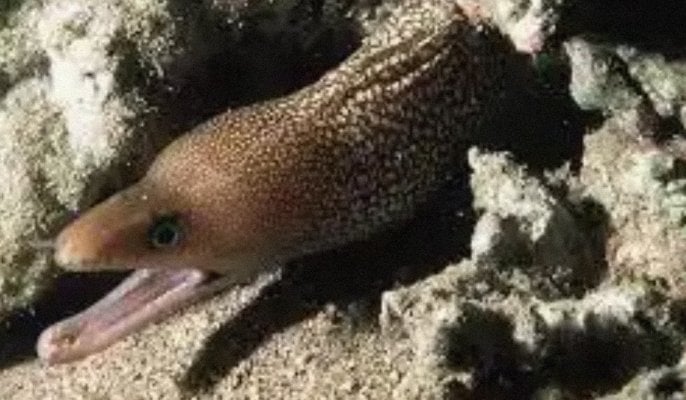
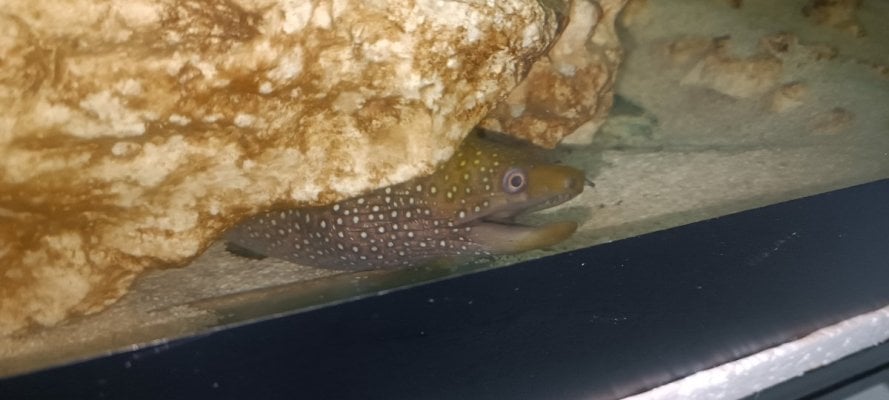

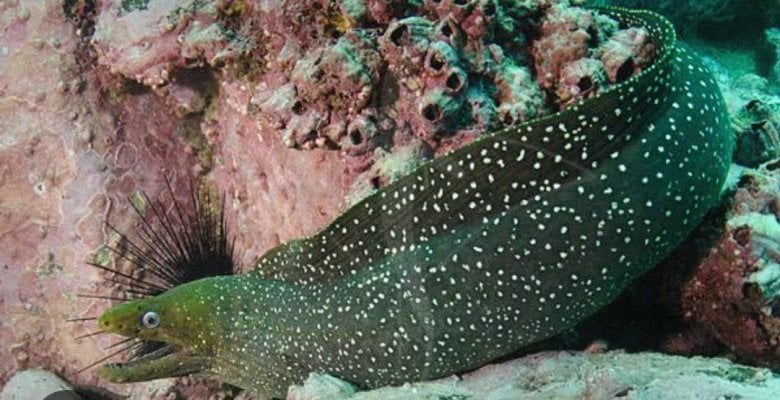
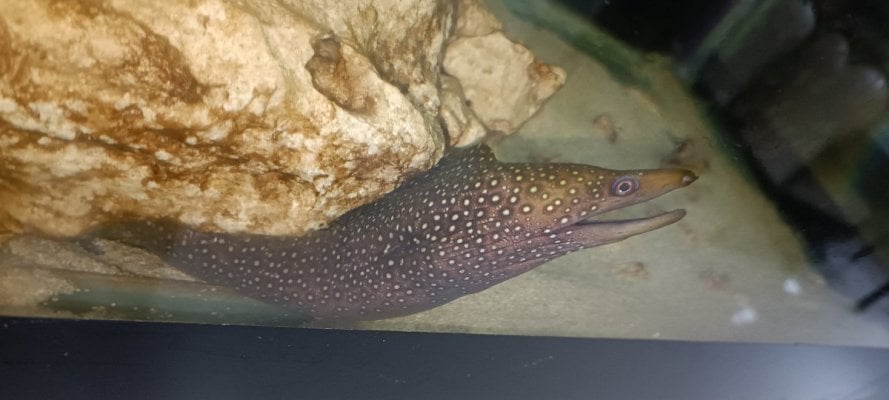
Last edited:
T
The last time I had an accurate Id of a eel was when i almost spent my whole night just searching up it's id hahaHaha, some days I pull up an ID thread and just set it aside for a few days until I feel up for searching for it.
Thanks to those lovely fish bases, i got my g. Dovii confused for first a turkey moray and after a turkey moray stout moray and now finally a dovii (unless that has to change aswell now haha)I can’t say better than you. I tried. Got annoyed at fishbases terrible photos/lack of photos and gave up. Not feeling the ID game today
Yeah, looking at those pics, there's definitely a difference there (personally, I'm guessing the punctatus pic there is actually a johnsoni, but I may well be wrong) - try the pics in the link below, and take a close look at the spots in the eel; in addition to seeming to have slightly larger spots, your eel shows dark circles around each white spot (ocellated spots) while G. dovii shows just the spots with no dark circles (at least none that I've seen on any of the specimens I've looked at).As much as I would like to say that it's indeed a gymnothorax punctatus i can't see the similarity, though it was hard to get these pics (i had to wait for a hour just for this guy to come out of his spot haha) I put down pictures of the punctatus at first and then the most accurate pictures of dovii I could find for a comparison, I believe that the dovii has more irregular spots unlike the punctatus whose spots are more in number and distributed like the white mouth moray, as for the dwarf moray I believe that the eel shown in the video is well over 2 feet and has a more pointed nose but I can see why you thought that this was a dwarf moray (Google search base also showed me a dwarf moray just now haha)






Photos of Red Sea Whitespotted Moray (Gymnothorax punctatus) · iNaturalist
And, yeah, I figured the dwarf moray was a long-shot guess there (I noticed the difference with the nose, but I'm not great at estimating the length, haha) - the main thing keeping me from thinking it's a different eel is the yellow apparent on the top of the fin, as that's not a color I would expect to see on most of the other possible species, and it seemed too uniform along the fin to be circumstantial, aberrant coloration in addition to the absent, typical patterning.
Haha, I've stayed up hunting down ID's far more often than I should, so I can definitely relate to thatT
The last time I had an accurate Id of a eel was when i almost spent my whole night just searching up it's id haha
My god! You hit the bullseye! Though it's saddening that I've been going about thinking that it was a different species and expecting him to grow to 6 feet like a dovii would this grows to about 3 feet correct? Thanks so much for the id!Yeah, looking at those pics, there's definitely a difference there (personally, I'm guessing the punctatus pic there is actually a johnsoni, but I may well be wrong) - try the pics in the link below, and take a close look at the spots in the eel; in addition to seeming to have slightly larger spots, your eel shows dark circles around each white spot (ocellated spots) while G. dovii shows just the spots with no dark circles (at least none that I've seen on any of the specimens I've looked at).
It's quite possible your eel isn't a punctatus, but I don't think it's a dovii - from what I've been reading, it's possible that it's an undescribed species currently, as the taxonomy around a lot of whitespotted moray species is something of mess that's still being sorted out (in fact, as discussed in the plazi link on punctatus above, they're not even sure if both of the eels used to describe the species are the same species at the moment, and the eels they found in their study seemed different from at least one of the two).
Photos of Red Sea Whitespotted Moray (Gymnothorax punctatus) · iNaturalist
www.inaturalist.org
And, yeah, I figured the dwarf moray was a long-shot guess there (I noticed the difference with the nose, but I'm not great at estimating the length, haha) - the main thing keeping me from thinking it's a different eel is the yellow apparent on the top of the fin, as that's not a color I would expect to see on most of the other possible species, and it seemed too uniform along the fin to be circumstantial, aberrant coloration in addition to the absent, typical patterning.
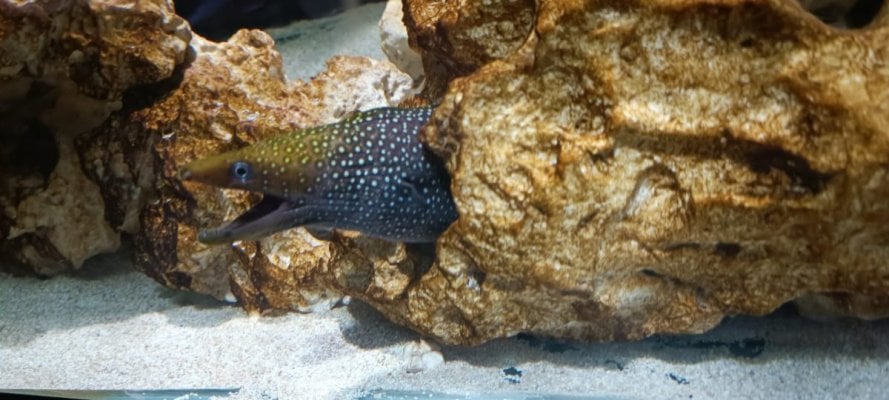
Last edited:
Yeah, seems ~31"-34.5" (~80-90 cm) is the expectation of max size here.
Similar threads
- Replies
- 6
- Views
- 446
- Replies
- 1
- Views
- 107



